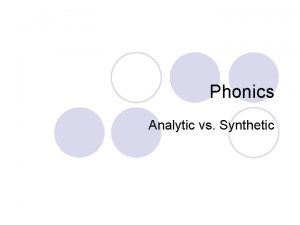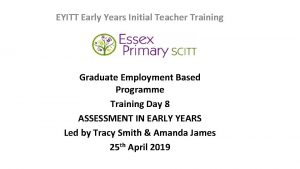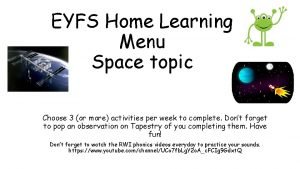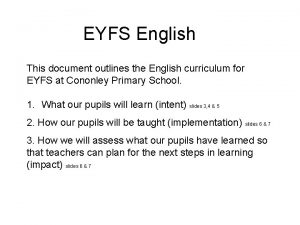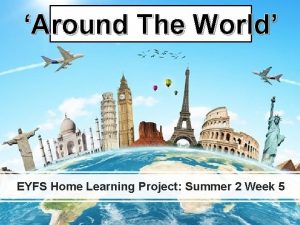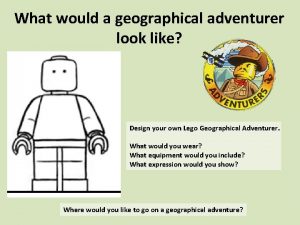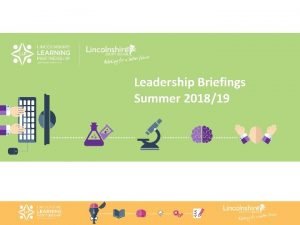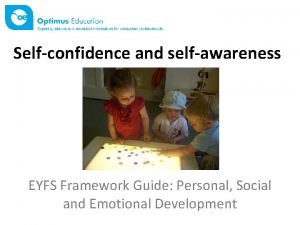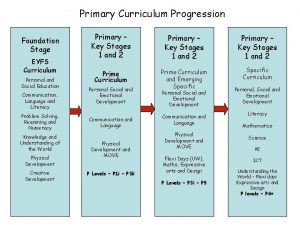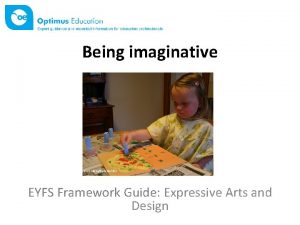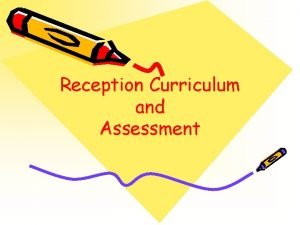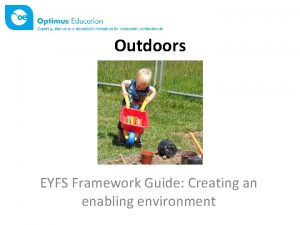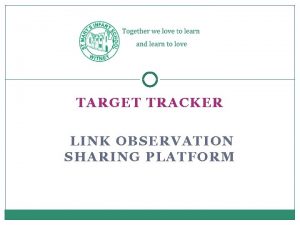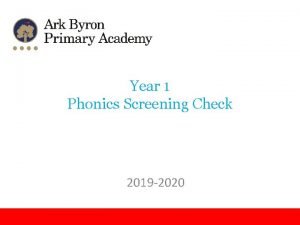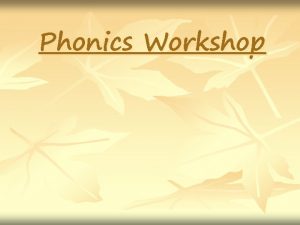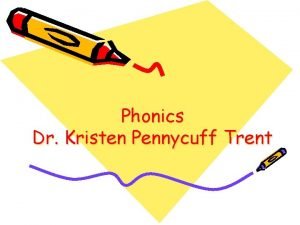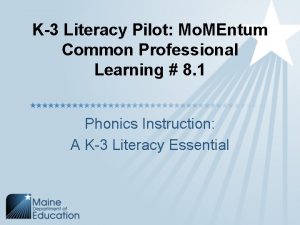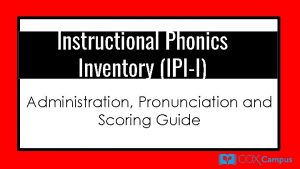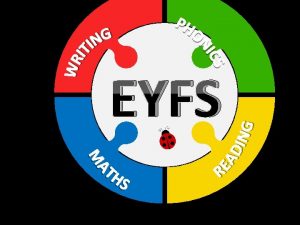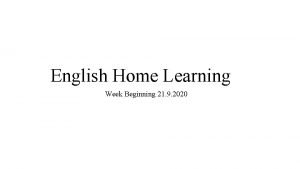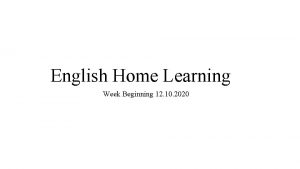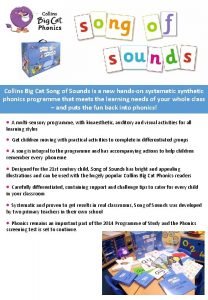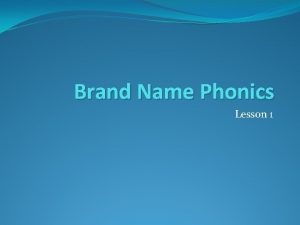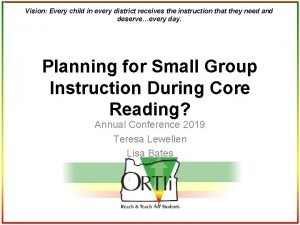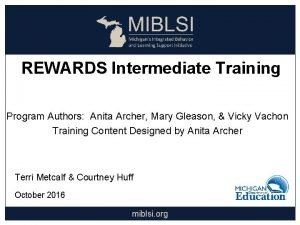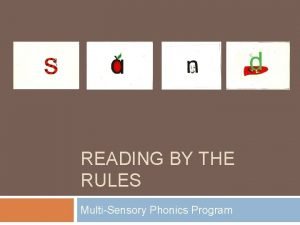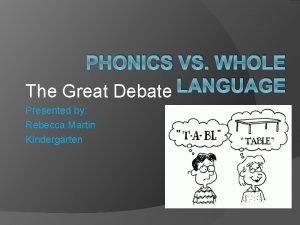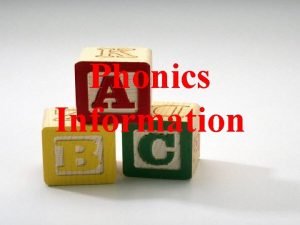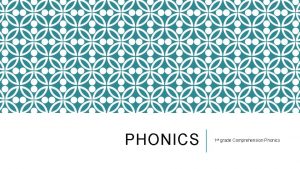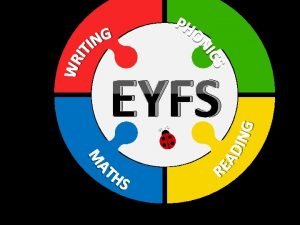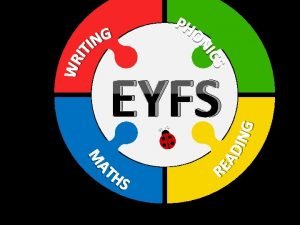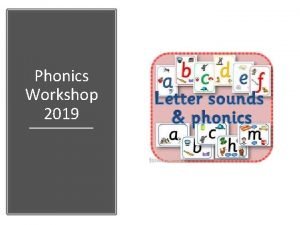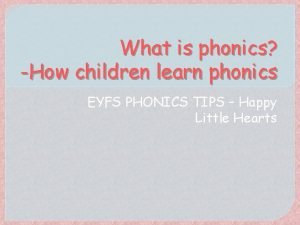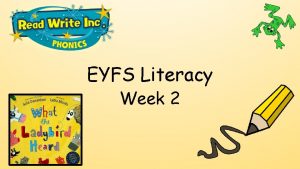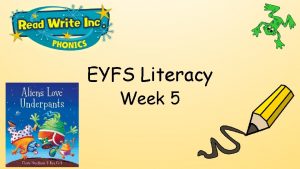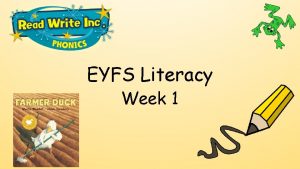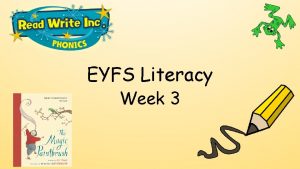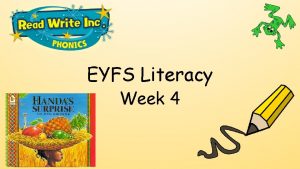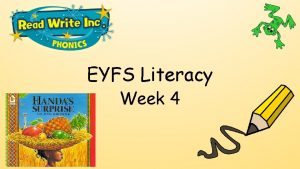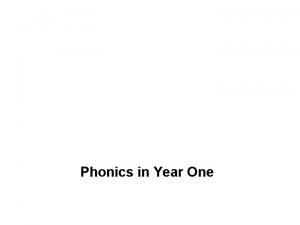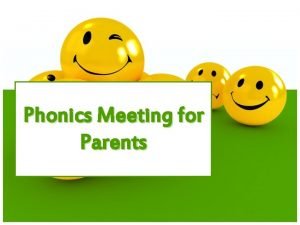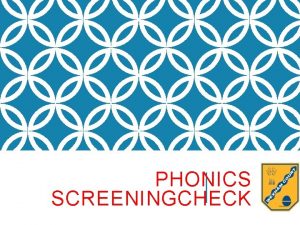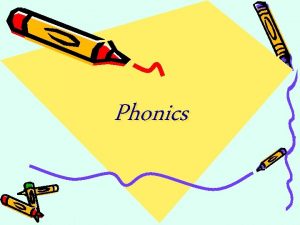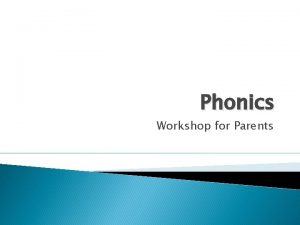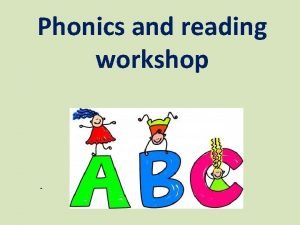EYFS To share with you how phonics is































- Slides: 31

EYFS

ü To share with you how phonics is taught in the Reception year at our school. ü To suggest ways that you may support your child at home. ü To share resources, practical tips and websites. EYFS ü To explain how we teach high frequency and tricky words. ü To share resources that will support your child at home. ü To explain how phonics links to other curriculum areas.

The ability to read has truly become a necessity to survive and thrive in today’s society. The best way to teach children to read is to ensure that a high quality, fun daily phonics programme is delivered to children. Phonics is a method for teaching reading and writing by developing learners' phonemic awareness—the ability to hear, identify, and manipulate phonemes—in order to teach the correspondence between these sounds and the spelling patterns (graphemes) that represent them. Also……… • It is proven that high quality daily phonic teaching secures the skill of word recognition. • Once mastered, most children are able to read fluently and automatically. • Once children are fluent readers they are able to concentrate on the meaning of the texts that they read. • Children can then move from learning to reading for pleasure and purpose. • Phonics also teaches skills for spelling and therefore improves standards EYFS in a child’s writing, as well as improving general academic confidence.

Phoneme – The smallest unit of sound in a word. Grapheme – Graphical representation of a sound/ phoneme – what the sound looks like when written. For some phonemes, this could be more than one letter e. g. t, ai, igh Digraph – a phoneme represented with 2 letters Trigraph – a phoneme represented by 3 letters. EYFS

In school, we follow the Letters and Sounds programme. Letters and Sounds is a phonics resource published by the Department for Education and Skills which consists of six phases. We run the Letters and Sounds programme alongside Jolly Phonics is very visual and practical and, in our opinion, works well within Phases 2 to 5 of Letters and Sounds. EYFS

‘Letters and Sounds’ was published by the Department of Education 2007. It is a straightforward document in which the programme for teaching children to read is set out in six phases over 4 years – Pre-School (Phase 1) up to Year 2 (Phase 6). It aims to build children's speaking and listening skills in their own right as well as to prepare children for learning to read by developing their phonic knowledge and skills throughout Pre-School, the Reception Year and also KS 1. It is a systematic programme for teaching phonic skills to children with the aim of them becoming fluent readers by age seven. EYFS

It is important that children know and understand how to blend and segment in order read and spell words correctly. Blending to read - when phonemes (units of sound) are merged together to pronounce a word. To read an unfamiliar word, a child must link a phoneme to each letter or letter group in a word and then merge them together to say the word = Grapheme-Phoneme Correspondence (GPC) e. g. sh – o – p / j– ee – p Segmenting to spell – When individual sounds are heard in a word. To spell a word, a child must segment a word into the individual phonemes and select the relevant grapheme to represent each of these phonemes. For example a child may write: ‘The cat was blak. It had a wiet tayl and a pinc noas. ’. EYFS

VC phase 2 CVC phase 2 & 3 on eat off dog boat chick CCVC trip train brought CVCC tent paint phase 4 & 5 yards EYFS

Phase 2 starts at the beginning of the Reception Year although some children will have been introduced to the first 6 sounds (satpin) in their nursery / pre-school setting. Phase 2 introduces 19 grapheme-phoneme correspondences (GPCs). As soon as children have learnt a small number of grapheme/ phoneme correspondences, blending and segmenting can begin. Set Phoneme Tricky words Set 1 s a t p Set 2 i n m d Set 3 g o c k I to the Set 4 ck e u r no go Set 5 h b f ff l ll ss into EYFS

Phase 3 introduces the remaining 7 phonemes /letters of the alphabet. Graphemes (digraphs) such as ch, oo, th represent the remaining phonemes not covered by single letters. Therefore, there are 25 phonemes within Phase 3. Once this phase is complete, children will have acquired the ‘code’ in order to blend sounds together for reading i. e. one grapheme for each phoneme in the English language. Children will also have many opportunities to learn letter names, spell tricky words, read high frequency words and will know approximately 42 phonemes in total! Set Phoneme Set 6 j v w x Set 7 y z zz qu Consonant digraphs ch sh th ng Vowel digraphs / trigraphs ai ee igh oa oo ar or oi ear air ure er Tricky words Revise previous / he she we me be was you they are all my her EYFS

This phase consolidates all the sounds that the children have learnt in the previous phases. There are no new sounds to learn. By Phase 4, children will blend phonemes to read CVC / CVCC / CCVC etc…. words and segment words for spelling. Children will have the opportunity to read simple two syllable words e. g. lunchbox, windmill. Children will practise reading all of the tricky words learnt so far and will also be able to spell some of these. Adjacent Consonants Tricky words CVCC (rent) said have like CCVC (slug) so do come some were CCVCC (stamp) there little one when CCCVCC (sprint) out what EYFS

Sound buttons can chop church EYFS

Phoneme frames EYFS

Jolly Phonics is a fun and child-centered method of teaching phonics to children. Each of the 42 letter sounds has its own action. This multisensory approach is extremely motivating for children and teachers alike. At our school, we believe that this practical/audible way of learning sounds works well alongside the Letters and Sounds programme. Children can visually be seen to use the actions to spell words. We believe that children learn in different ways, and the Jolly phonic ‘way’ really does work with some children! The five basic skills for reading and writing are: 1. Learning the letter sounds 2. Learning letter formation 3. Blending 4. Identifying sounds in words 5. Spelling the tricky words EYFS

Jolly phonics - (sound, action, grapheme) EYFS

Alongside learning all of the phonemes, it is important that children know how to write graphemes correctly. There are many ways that we practise this at our school. EYFS

Careful pronunciation of sounds is very important to ensure that we are good language models to children. Sounds should be pronounced softly and in a clipped, short manner. Not with a ‘uhhh’ sound. E. g. Cuh aaa tuh - C-a-t EYFS

Phonics is taught daily at 9 am and usually lasts approximately 20 minutes. The format of the lesson is the same everyday which enables children to grow accustomed to the 4 different parts of the lesson. The first part of the daily phonics lesson is called: REVISIT This section of the lesson revisits previously learnt sounds and tricky words. Flashcards may be displayed to recall graphemes and the children then say the relevant sounds. EYFS

The second part of the lesson introduces and teaches the new sound/s of the day. The teacher models how to blend and segment throughout this section. The new Jolly Phonic action is taught and children may also have opportunities to write the new sound, forming letters correctly. TEACH This section of the lesson also introduces new tricky words. Children may have the opportunity to read words and sentences including the new sound/s and tricky words which puts them into a context. EYFS

The third part of the lesson gives the children opportunities to practise segmenting and blending the new phonemes and tricky words. This may be done through a variety of fun games and activities PRACTISE The children enjoy the variety of games and grow confident when they play them daily. EYFS

Buried Treasure aim pain rain main Spain chain How many coins can you collect?



The final part of the lesson gives the children opportunities to apply their knowledge of the new phonemes and words. APPLY The children may read or write simple captions or word lists and am also think of their own example. EYFS

http: //jollylearning. co. uk/2010/10/29/hear-the-letter-sounds/ http: //www. rainbowresources. co. uk/#/letters-sounds/4549552053 www. bbc. co. uk/schools/ks 1 bitesize www. topmarks. co. uk http: //www. kenttrustweb. org. uk/kentict/content/games/ www. ictgames. com/literacy http: //www. bbc. co. uk/schools/wordsandpictures/index. shtml http: //www. letters-and-sounds. com www. phonicsplay. co. uk EYFS https: //www. phonicsplay. co. uk/Picnic. On. Pluto. html http: //jollylearning. co. uk

All children develop at different ages and stages and therefore we ensure that progress is monitored in phonics session regularly. This is a rough guide to where children should be in each year group. ü By the end of reception children will have been taught and know at least one way of representing each phoneme. ü By the end of year 1 children will have been taught and know alternative graphemes for each grapheme and different pronunciations of the same grapheme and use these to read and spell. ü By year 2 children are applying their phonic knowledge and recognising irregularities to spell more complex words and notice spelling patterns. EYFS

High frequency words (keywords) are words that we use regularly when we speak, read and write. These words can be sounded out phonetically. There are several ways that we learn these……. • Write the word on paper, cut out each letter and put the word back together. • Write the word three times. Trace over it in different colours. • Look, say, cover, visualise, write, check. • Play bingo with the words. • Write the word in a nonsense sentence. • Find words with similar patterns. e. g. the, them, they • Write the word, draw around the shape of the word and cut out. • Put words into alphabetical order. EYFS


Alongside the teaching of high frequency words, we teach “tricky” words which cannot be sounded out when phonemes are blended. Tricky words are taught as WHOLE words by sight. We send home KEYWORDS in your child’s phonics book. The black words are decodable (HFW) and the red words are TRICKY words. EYFS

The more phonics practise that children have the better, therefore it is so beneficial if you can support your children at home as and when you can. But not too much! Just five minutes a night is ample. Children may even want to do more as they become more confident! Your children will receive new keywords as they learn them and by the end of the year the book will contain all of the phonemes for the Reception Year. Please do remember to keep it entertaining and as practical as possible! HAVE FUN! EYFS

 Synthetic phonics vs analytic phonics
Synthetic phonics vs analytic phonics Eyfs principles
Eyfs principles Eyfs space activities
Eyfs space activities Eyfs english curriculum
Eyfs english curriculum Around the world eyfs
Around the world eyfs Eyfs geography
Eyfs geography Eyfs profile data 2018
Eyfs profile data 2018 Eyfs
Eyfs Eyfs curriculum progression
Eyfs curriculum progression Mark making early years
Mark making early years Hampshire early years advisory team
Hampshire early years advisory team Being imaginative eyfs
Being imaginative eyfs What is eyfs
What is eyfs Enabling environments eyfs
Enabling environments eyfs Target tracker eyfs observations
Target tracker eyfs observations Phonics screening test 2019
Phonics screening test 2019 Rose report 2006
Rose report 2006 Phonics generalization
Phonics generalization Blending lines phonics
Blending lines phonics Phonics inventory assessment
Phonics inventory assessment Jolly phonics p
Jolly phonics p Jolly phonics d
Jolly phonics d Jolly phonics f
Jolly phonics f Collins big cat phonics for letters and sounds download
Collins big cat phonics for letters and sounds download Llll scope and sequence
Llll scope and sequence Words that rhyme with eraser
Words that rhyme with eraser Ecri phonics
Ecri phonics The phonics dance
The phonics dance Anita archer rewards
Anita archer rewards Multisensory phonics
Multisensory phonics Phonics vs whole language
Phonics vs whole language Phase 5 tricky words
Phase 5 tricky words
